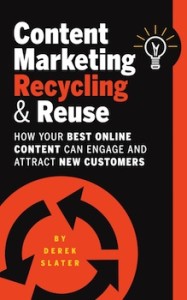 Late last year, Online Content Marketing In 30 Minutes author Derek Slater and I discussed the idea of breaking out some of the chapters of his book, and releasing it as an inexpensive, standalone miniguide for content marketing professionals. He quickly identified the topic that was most suitable — the recycling and reuse of existing content, which had been covered in chapters 4 and 6 of Online Content Marketing In 30 Minutes. The miniguide was just published as Content Marketing: Recycling & Reuse – How your best online content can attract and engage new customers, and is available now for just 99 cents as a Kindle version, an iBooks version for the iPad and iPad mini, a Google Play version that can be read on the Samsung Galaxy Tab, Nexus 7, and other Android tablets, and a PDF that can be printed out or read on practically any computer screen.
Late last year, Online Content Marketing In 30 Minutes author Derek Slater and I discussed the idea of breaking out some of the chapters of his book, and releasing it as an inexpensive, standalone miniguide for content marketing professionals. He quickly identified the topic that was most suitable — the recycling and reuse of existing content, which had been covered in chapters 4 and 6 of Online Content Marketing In 30 Minutes. The miniguide was just published as Content Marketing: Recycling & Reuse – How your best online content can attract and engage new customers, and is available now for just 99 cents as a Kindle version, an iBooks version for the iPad and iPad mini, a Google Play version that can be read on the Samsung Galaxy Tab, Nexus 7, and other Android tablets, and a PDF that can be printed out or read on practically any computer screen.
“Recycling” has negative connotations in mass media. As Derek points out in his introduction, who wants to re-read old news? But certain types of content are suited to reuse and recycling. A content marketing strategy that integrates recycled content can breathe new life into information that has resonated with readers and customers in the past. New readers — and new customers — can derive value from this content, even if it’s years old.
In addition to selecting suitable evergreen content, content marketers have to consider the format(s) that will be used to resurface the content. It’s not simply a matter of copying and pasting text or reposting an old video. Derek describes eight ways content can be repackaged, ranging from “best of” link lists to content reborn in a new format, such as a video or ebook. One of my favorite examples in the miniguide is a Harvard Business Review publication titled “HBR’s Ten Must-Reads: The Essentials“. Derek describes it as follows:
It costs $24 to download. There is no new writing or editing involved — not so much as one word of an introductory blurb. The content consists of ten articles, in their entirety, from previous editions of the magazine.
One of the articles was originally published in 1974. They are still selling it today.
May your content live so long, and prosper so well.
As in his first book, Derek makes sure that Content Marketing: Recycling & Reuse gives a strategic approach that emphasizes context as well as practical tips, including lots of examples. He even includes a bunch of killer headline templates that a good blogger can start using right away.
Here is the table of contents to the miniguide:
- Foreward
- Introduction: Why Recycling & Reuse Is So Important
- Context: The Secret to Reusable Marketing Content
- Context And Content Shelf-Life
- Content Recycling Vs. Google Penalties
- 8 Ways To Recycle Content
- Bonus: 9 Killer Headlines
- Conclusion
Content Marketing: Recycling & Reuse is aimed at anyone who is responsible for producing website content, building engagement, or using content to generate leads — that is, bloggers, journalists, editors, e-commerce managers, inbound marketers, social media managers, and SEO specialists. For just 99 cents, you’ll get some fresh ideas about how to leverage existing content to attract new readers and potential customers. Available formats include a Kindle version, the iBooks version for the iPad and iPad mini, a Google Play version that can be read on the Samsung Galaxy Tab, Nexus 7, and other Android tablets, and a PDF that can be printed out or read on practically any computer screen. More information about how the guide can be found here.
